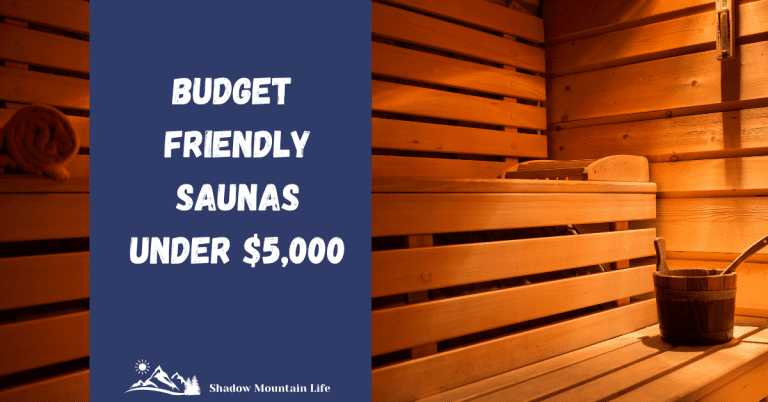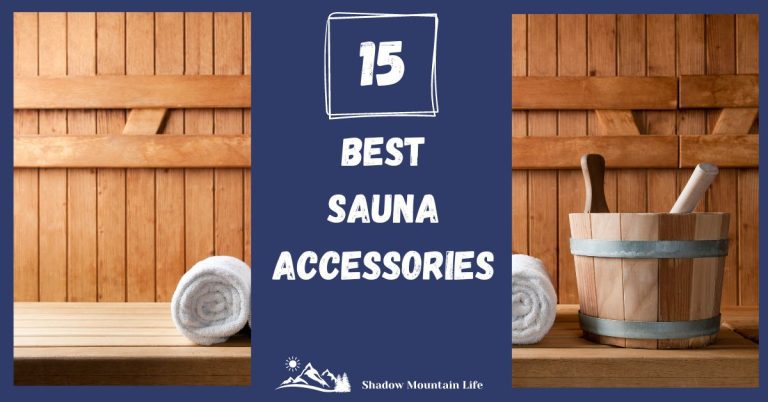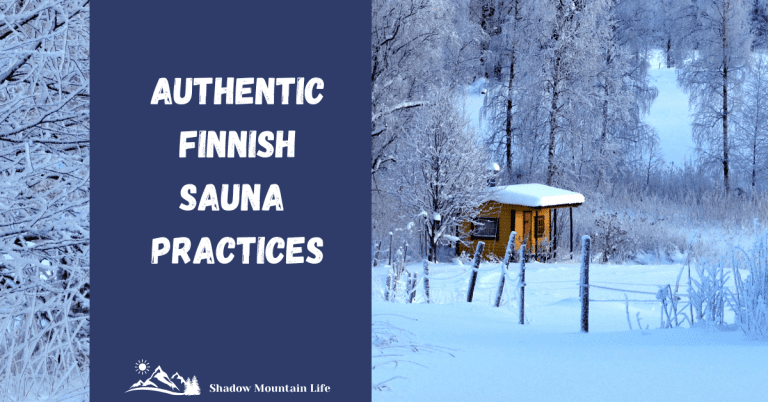Top 10 Sauna and Cold Plunge Benefits
Medical Disclaimer: We are not doctors. The health information in the article is for informational and educational purposes only. Please consult your doctor or other healthcare professional when making medical decisions.
Affiliate Disclaimer: We may make a commission if you purchase something through our links. Thank you!

Background: Sauna and Cold Plunge Benefits
In the world of wellness and holistic health, sauna and cold plunge therapy have emerged as powerful tools for physical and mental rejuvenation.
Sauna therapy, rooted in ancient traditions, involves exposure to high temperatures in a controlled environment, promoting sweating and relaxation. Cold plunge therapy, on the other hand, entails brief immersion in cold water, stimulating the body’s natural responses to extreme temperatures.
The Nordic Cycle is a traditional practice in Scandinavian countries and involves alternating between hot saunas and taking cold-water dips. This cycle typically consists of 10-15 minutes in a sauna (180-200°F), followed by a quick plunge into cold water or snow (32-50°F). The process is repeated 2-4 times.
The combination of these therapies, known as contrast therapy, has gained significant popularity in recent years, attracting athletes, health enthusiasts, and those seeking natural ways to enhance their well-being and health. This growing trend is supported by a mounting body of scientific evidence highlighting the numerous benefits of alternating between hot and cold exposures.
In this article, we’ll explore the top 10 benefits of incorporating sauna and cold plunge routines into your wellness regimen, and how this simple yet powerful practice can transform your health, boost performance, and improve overall quality of life.

What is Contrast Therapy?
Contrast therapy, also known as hot/cold immersion therapy, is a treatment method that alternates between heat and cold exposure to stimulate the body’s natural healing processes.
The fundamental principle behind contrast therapy lies in its ability to manipulate blood flow and trigger physiological responses. When exposed to heat, such as in a sauna, blood vessels dilate, increasing circulation and promoting relaxation. Conversely, cold shock, like a plunge in icy water, causes blood vessels to constrict, reducing inflammation and stimulating the nervous system.
By alternating between these extremes, this therapy creates a pumping effect in the circulatory system, enhancing blood flow, lymphatic drainage, and cellular exchange. This process can lead to a range of benefits, from improved recovery and reduced muscle soreness to enhanced immune function and mental clarity. As we continue to learn more about hot and cold therapy, we find that it is a powerful tool for overall health and wellness.

Top 10 Sauna and Cold Plunge Health Benefits
1. Improved Circulation
Alternating between hot and cold exposures stimulates blood flow throughout the body. A study in the European Journal of Applied Physiology found that contrast therapy improved blood flow and reduced muscle soreness in athletes.
2. Enhanced Recovery for Athletes
Contrast therapy can significantly reduce muscle soreness and accelerate recovery after intense exercise. A 2013 meta-analysis published in PLOS ONE concluded that contrast water therapy was superior to passive recovery in reducing muscle soreness.
3. Boosted Immune System
Using a sauna regularly combined with cold exposure can enhance the immune system’s function. A study in the Annals of Medicine showed that frequent sauna bathing was associated with reduced risk of respiratory infections.
4. Increased Metabolism and Weight Loss
The alternating hot and cold exposure can boost metabolism and potentially aid in weight loss. A small study published in the Journal of Clinical Investigation found that cold temperature exposure increased brown fat activity, which can lead to increased calorie burn.
5. Reduced Inflammation
Contrast therapy has been shown to have anti-inflammatory effects on the body. A study in the European Journal of Applied Physiology demonstrated that cold water immersion after exercise reduced inflammatory markers in the blood.
6. Improved Cardiovascular Health
Regular sauna use, when combined with cold exposure, can have positive effects on heart health. Short-term stresses, like sauna use increases the heart rate and strengthens the heart muscle. A long-term study published in JAMA Internal Medicine found that frequent sauna use was associated with reduced risk of cardiovascular disease and all-cause mortality.
7. Enhanced mental Clarity and Focus
The shock of cold water after heat exposure can increase alertness and mental clarity. While more research is needed, a study in Medical Hypotheses suggested that cold water adaptation and taking a cold plunge could have antidepressant effects.
8. Better Sleep Quality
Contrast therapy may improve sleep quality by regulating body temperature. A study in the European Journal of Applied Physiology found that a hot bath before bedtime improved sleep quality in young adults. Similarly, a hot sauna relaxes and cleanses the body before bed.
9. Stress Reduction and Relaxation
The practice of alternating between heat therapy and cold can promote relaxation and reduce stress. Research in Complementary Therapies in Medicine showed that sauna bathing reduced stress and improved well-being in participants.
One way these therapies help with relaxation is that the extreme temperatures force you to be in the moment. It is a great (even a short) disconnect from the stress of modern everyday life.
10. Detoxification and Skin Health
Sweating in the sauna followed by cold exposure can help cleanse the skin and potentially aid in detoxification. While more research is needed on detoxification claims, a study in the Journal of Cosmetic and Laser Therapy found that infrared sauna use improved skin appearance and collagen production.
How to Properly Alternate Sauna and Cold Plunge Sessions
Recommended Duration and Frequency for Each Session
To maximize the benefits of contrast therapy, it’s important to follow proper protocols. Begin with a 10–15-minute sauna session at temperatures between 170-190°F (76-88°C). Follow this immediately with a 1–3-minute cold plunge in water around 50-59°F (10-15°C).
Repeat this cycle 2-4 times, always ending with cold exposure. The reason for ending with cold exposure is to keep inflammation in the body down.
The total duration of your contrast therapy session should be 30-45 minutes. It’s recommended to start with shorter durations and gradually increase as your body adapts. Aim for 2-3 sessions per week, allowing for recovery days in between.
Safety Precautions
Always listen to your body and exit either the sauna or cold plunge if you feel dizzy or uncomfortable. Stay hydrated throughout the process, drinking water before, during, and after your sessions.
Those with certain health conditions, such as heart problems, respiratory problems, diabetes or pregnancy, should consult a healthcare professional before starting contrast therapy.
Tips for Getting Started with Contrast Therapy
Start with a Shower
For those new to contrast therapy, starting at home can be a comfortable way to begin. A hot shower followed by a cold shower can mimic the effects of sauna and cold plunge, though less intense. Gradually increase the temperature contrast and duration as you become more comfortable.

Try a Sauna Blanket or Sauna Tent
Your next step could be to try a home sauna blanket or portable sauna tent by North Shore Saunas for a more authentic experience. These are cheaper alternatives than a full backyard sauna and take up very minimal space.
If you end up really enjoying the sauna and have the space, look into investing in a backyard or in-home sauna. Finnish saunas or infrared saunas will both work, but Finnish saunas are more authentic and incorporate the use of a sauna stove and steam.

Cold Plunge Options
For cold therapy, you can start with an ice bath or cold shower in your bathroom. There are also multiple options ranging from a few dollars (use a kiddie pool) to slightly more expensive (stock tank in the backyard). These are cheap and effective ways to try out cold plunging without investing in an expensive model at the start.
When you decide to invest in a high-end cold plunge tub, make sure to get one that is complete with a chiller to keep the water temperature constant. Locate it as closely as possible to your sauna to maximize the therapy benefits. Both Redwood Outdoors and Plunge offer a variety of high-end models at different price-points.

Check your Gym
If you live in an apartment and don’t have a backyard, check with your local spas or wellness centers which often offer contrast therapy facilities. This can be a great way to experience professional-grade equipment before investing in your own.
Conclusion
The practice of alternating between a hot sauna and cold plunge offers many potential health benefits, from improved circulation and enhanced athletic recovery to stress reduction and better sleep quality.
This ancient wellness technique, backed by modern scientific research, provides a holistic approach to physical and mental well-being. By understanding the proper techniques for contrast therapy and starting with manageable steps, anyone can incorporate this powerful practice into their wellness routine.







